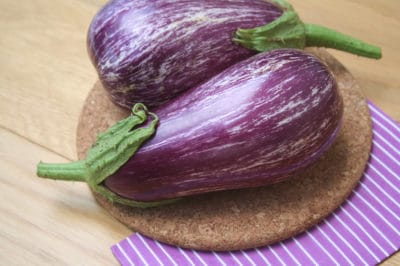When to Harvest
Harvesting eggplants varies, depending on the variety. Some eggplants are ready to pick 10 days after flowering, while others can take up to 40 days. The best time to harvest your eggplants is before the seeds get too large, and begin to harden. You can tell your eggplants are ripe if they have glossy skin, and feel firm when you press them with your finger. If you let eggplant grow too long, the flesh becomes bitter.
What Is the Best Temperature for Storing Eggplant?
The storage time for eggplants is less than two weeks before they start deteriorating. For the longest storage, keep the temperature from 50°F (10°C) to 54°F (12°C). Watch the temperature closely because storing at higher temperatures will decay the eggplants, while lower temperatures result in chilling injuries.
What Are the Symptoms of Chilling Injuries?
Eggplants are sensitive to temperatures lower than 50°F (10°C). When the temperature reaches 41°F (5°C), damage to your eggplants occurs.
These are the symptoms from eggplants stressed by chilling:
- Pitting
- Brown seeds
- Skin bronzing
- Brown pulp
If your eggplants become frozen, the pulp will turn brown and waterlogged, so freezing raw eggplant is not a storage option.
What Is the Best Way to Keep Eggplants Fresh?
The best way to keep your eggplants fresh after harvesting is to cool them down to 50°F (10°C) quickly. This prevents water loss in the eggplants. If you have Japanese eggplants, they lose three times more water than American varieties. The signs of water loss in eggplants are wrinkled skin, spongy pulp, dull skin and brown calyx.
What Are the Best Containers for Eggplant Storage?
To help prevent water loss, store your eggplant in moist paper or waxed containers. Plastic bags with aeration holes are also effective for preventing water loss and decay. If you use non-perforated plastic bags, the humidity increases, causing condensation. This excess moisture leads to mold and bacteria growth on your eggplants.
How to Preserve Eggplant
Although freezing causes damage and waterlogged pulp to raw eggplant, you can freeze it, if you blanch it first. To do this, wash and peel your eggplant, then cut it into thick slices. Put your sliced eggplant into a strainer and lower it into one gallon of boiling water, mixed with a half-cup of lemon juice. Put a cover on the pot, and blanch the eggplant for about four minutes. After blanching, drain and cool the eggplant. Seal it into plastic freezer bags, leaving a half-inch space at the top.
How Long to Store Eggplant for the Best Flavor
The best way to store eggplant, if you want tender, sweet pulp is for two days in a paper bag, or open basket on the counter. If your house is hot and humid, or if you need to store your eggplants for a longer time, five days in the refrigerator will give you the best flavor. The longer you store it, the more flavor the eggplants lose. Eggplants always taste the best when you use them right after picking.
Try to avoid placing them near apples, melons, bananas or melons because these fruits produce ethylene, which causes eggplants to brown rapidly.
